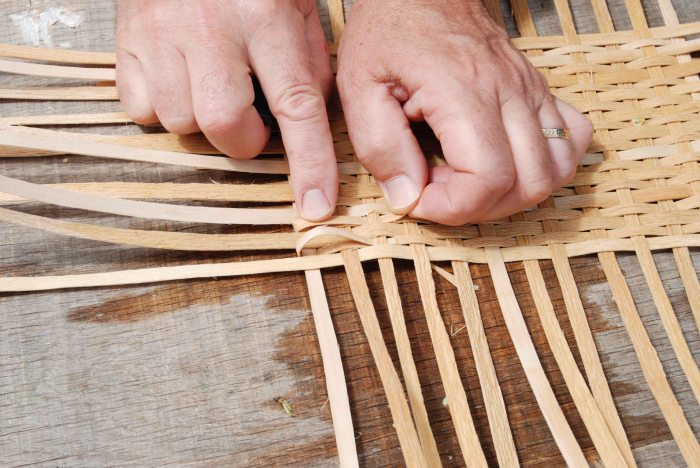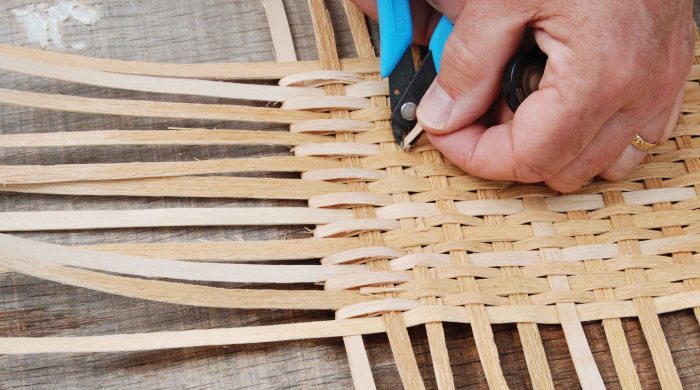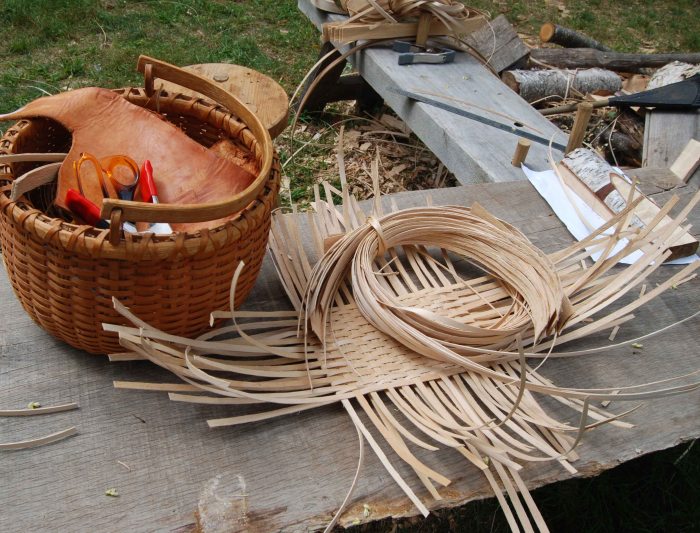Basket bottoms. Two of our household baskests; c. 1987-90. The one on the left is a standard item; square bottom, round top. Ash with hickory rims; hickory bark lashing. The one on the right is our colored-pencil basket. Gets lots of use. A rectangular basket, all ash, rims either oak or hickory.

Here’s the bottom of the square one. Typical weave, resulting in openings between the uprights. Probably most splint baskets are like this.

Here’s what I call a “filled” bottom – thin and narrow filler strips woven between the uprights.

The filled bottoms of baskets are made a few different ways. One is to make a round basket, with “spokes” laid out to form the bottom and sides. I do these with 16 uprights; laid out in 2 batches of 8 spokes. Here’s the underside of our laundry basket; showing this spoke bottom from below.

Each upright, or spoke, is cut into an hourglass shape; so its middle section is narrower than its ends. This makes it easier to weave these things all close together. One spoke is cut in 2, down to the middle. This photo shows these first 8 pieces; the one my left hand is on has been cut down the middle to make an odd number of uprights.

I then take a thin, narrow weaver and start to weave these 8 pieces (9 really…) together.

Once the weaver makes a few trips around you get out to the point at which you can add in the next 8 pieces. I add these pieces one at a time, the weaver catches each one in turn and binds it to the section already woven. No need now to split one of these; things are up & running now. Around & around this goes, and you bend things upright after a certain point, to begin to form the basket’s shape.

The other filled bottom is a rectangular (I guess it could be square too, but I always made then rectangles) bottom, with filler strips laid in between the uprights. In this case, there’s 3 different pieces to deal with – the short uprights, the long dittos, and the thinner filler strips. These are just a bit longer than the finished bottom of the basket. So I start with laying the long uprights down, with filler strips between them. Then alternate in the short uprights over & under the previous bits. It gets a little complictated – it’s like when I teach joinery and carving – now for 2 consecutive thoughts, and sometimes 3.
This photo shows the first 3 of each upright, with 2 narrow thin fillers between the long uprights (those that run across this photo horizontally) Then I add in each kind of splint in pairs, the longs/shorts/fillers- as the case might be. I always work out from the center. Easier to keep things even that way. Usually.

I’ve got the polished satin-y finish of the fillers inside the basket – they appear bright white in the photo. Remember, all this stuff is very wet as I weave it.

This is the finished laid-up bottom. Next is to tuck the filler strips in.

I bend them back on themselves, and tuck them under the the 3rd upright -they have to go over the first two because of the weaving pattern. It just is. Then pull it tight, and trim it off just under the upright.


I wove two bottoms like this, then piled up some weaving material; and will re-soak these and weave up the bodies next time I get the basket stuff out. Maybe tomorrow, it’s nice work for a hot day.


























































